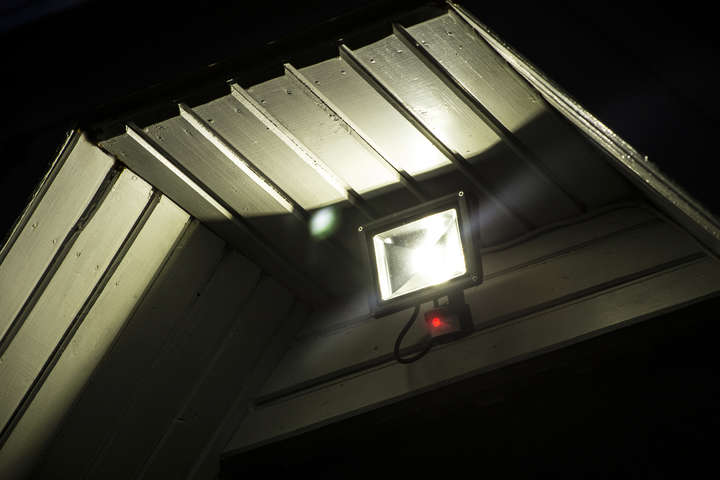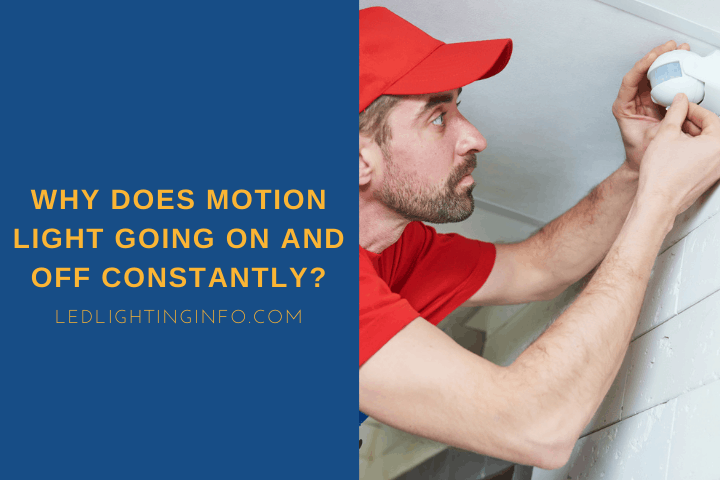There are a lot of great reasons to have a motion-detecting light installed at your home.
They’re great for security, helping to deter intruders who don’t want to be spotted, and they’re helpful if you arrive home during bad weather and need to spot any icy patches on your porch.
Indoor sensors also let you control your lighting automatically, so you don’t trip over unseen hazards when you enter a room.
They aren’t great when they don’t work properly – either malfunctioning or too sensitive to motion.
If your motion light resembles a strobe light, or it’s just switching on regularly when you can’t see anything that should be triggering it, it can be highly annoying.
A motion light switching on and off could be due to many reasons. Incompatible LED bulbs are common, but also, the sensor may be faulty or damaged power bumps, or even spiders. Try changing the bulb, resetting the sensitivity, or replacing the sensor if nothing else works.
In this article I’m going to explain:
- The reasons your motion sensor might be triggering when you don’t want it to
- Whether resetting it can help
- How else you can fix your motion sensor detector
Why Does My Motion Sensor Activate For No Apparent Reason?

First, there’s an important distinction to make here.
Is the light in your motion sensor circuit constantly flickering on and off? Or is it turning on occasionally when it shouldn’t?
If it’s flickering, that helps narrow down the problem because it’s not going to be the sensor that’s the problem.
Why?
Because a faulty sensor can make your light switch on too frequently, but it can’t then turn the bulb off so fast to cause it to flicker.
With flickering, it’s either going to be a problem with the circuit, the bulb, or the connection between the bulb and the fitting.
If there’s any debris, or it’s just not been installed correctly, it could flicker as it keeps hitting and then losing the connection.
Modern motion sensors are often incompatible with certain LED bulbs because their constant power draw then causes the bulb to switch on and off if it’s wired in-line in the circuit.
If you swap out your LED bulb for an incandescent one and it works, then you know it’s a compatibility issue.
You then need to decide whether to keep using less efficient lights or swap the sensor for an LED-compatible one.
Now, what about when it’s not that your light is flickering, but it keeps turning on and off every now and then when it shouldn’t?
This could be down to power surges – not big ones that damage your circuits.
Still, just small bumps that you can sometimes get can play havoc with the sensor without causing any serious problems.
A good quality sensor will have the necessary components to handle these slight changes.
Another reason is that your motion sensor is too sensitive – some have different settings.
Yours might be on one, which means it is triggered from even the slightest movement in a room, something that you’re barely aware of.
And it may just be that something is interfering with your sensor – if your home is a haven for spiders.
Lastly, wind can often set off the motion sensor by moving objects like tree branches or unsecured backyard furniture.
The bottom line is, each of these has different fixes, so let’s talk about them.
Will Resetting Motion Detector Sensor Help?

Most good-quality motion detectors are triggered by heat.
They do this so that the swaying of a branch in view won’t cause the light to come on for no reason.
But lower-quality sensors will react to simple movements, even from plants or non-living items.
Some of these motion sensors have a sliding scale of sensitivity.
These will give you the option to only trigger the light when significant movement is detected.
Alternatively, make it more sensitive so that even a tiny change in the field of view will spark the sensor into life.
When you reset the motion detector, it can restore it to factory settings, which can help with any developed problems.
For some sensors, it’s actually switching the sensor off that changes the sensitivity.
Say you have a standard toggle switch installed with a motion sensor, every time you flip it on after being turned off, the sensitivity will have changed to the following setting.
This is because you unplug the sensor from the circuit and connect the power back with each flip.
You may need to cycle through this a few times to get to the level of sensitivity you want.
Ultimately you need to check how your motion detector works and determine if switching it off and on will alter the sensitivity.
If it does, then you know the cause so it could help stop it from triggering too often.
How To Fix A Triggering Motion Sensor Detector?

So, how do you fix a motion sensor that is triggering too often?
Firstly, try the reset I’ve detailed above. If it’s a sensitivity issue, then you need to make it less sensitive.
Check the manual for your specific motion detector – it might have a sliding control on the sensor itself, or it may need you to reset it by powering it off for thirty seconds.
Once you’ve ruled out the sensitivity issue, check the sensor itself for signs of insects and arachnids or for damage.
If there are spider webs around the sensor, give it a good clean along with the area around it, and consider swapping to a PIF sensor that detects heat.
The thing is, spiders are cold-blooded, so they won’t set those sensors off.
Say the sensor isn’t damaged, and you can’t see any signs of spiders causing issues.
There’s a good chance it’s being caused by power bumps on the circuit, which will mean you’ll need to upgrade your sensor to a better quality one.
It’s rare to find this level of detail on a product page on a website, so just look for branded sensors with positive, genuine reviews, so you know you’re getting a reliable sensor.
Final Words
A motion sensor triggering repeatedly is annoying but not an unsolvable problem.
If it’s constantly flickering, check that your bulb is compatible and has been installed correctly.
Instead, for triggering at random times, check the sensitivity and make sure no spiders are crawling over it all the time.
Replacing your sensor will solve the issue if it’s a cheaper one that can’t handle power fluctuations or if it has been damaged.
Have you had problems with motion sensors causing your lights to constantly switch on when they don’t need to? How did you solve it?
Let me know in the comments.

